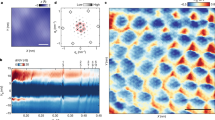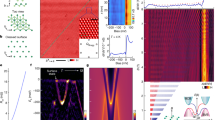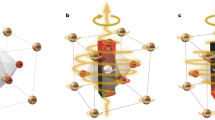Abstract
Hybrid quantum materials allow for quantum phases that otherwise do not exist in nature1,2. For example, a one-dimensional topological superconductor with Majorana states bound to its ends can be realized by coupling a semiconductor nanowire to a superconductor in the presence of a strong magnetic field3,4,5. However, the applied magnetic fields are detrimental to superconductivity, and constrain device layout, components, materials, fabrication and operation6. Early on, an alternative source of Zeeman coupling that circumvents these constraints—using a ferromagnetic insulator instead of an applied field—was proposed theoretically7. Here, we report transport measurements in hybrid nanowires using epitaxial layers of superconducting Al and the ferromagnetic insulator EuS on semiconducting InAs nanowires. We infer a remanent effective Zeeman field exceeding 1 T and observe stable zero-bias conductance peaks in bias spectroscopy at zero applied field, consistent with topological superconductivity. Hysteretic spectral features in applied magnetic field support this picture.
This is a preview of subscription content, access via your institution
Access options
Access Nature and 54 other Nature Portfolio journals
Get Nature+, our best-value online-access subscription
$29.99 / 30 days
cancel any time
Subscribe to this journal
Receive 12 print issues and online access
$209.00 per year
only $17.42 per issue
Buy this article
- Purchase on Springer Link
- Instant access to full article PDF
Prices may be subject to local taxes which are calculated during checkout




Similar content being viewed by others
Data availability
Source data are provided with this paper. All other data that support the plots within this paper and other findings of this study are available from the corresponding author upon reasonable request.
References
Stern, A. Non-Abelian states of matter. Nature 464, 187–193 (2010).
Fu, L. & Kane, C. L. Superconducting proximity effect and Majorana fermions at the surface of a topological insulator. Phys. Rev. Lett. 100, 096407 (2008).
Oreg, Y., Refael, G. & von Oppen, F. Helical liquids and Majorana bound states in quantum wires. Phys. Rev. Lett. 105, 177002 (2010).
Lutchyn, R. M., Sau, J. D. & Das Sarma, S. Majorana fermions and a topological phase transition in semiconductor–superconductor heterostructures. Phys. Rev. Lett. 105, 077001 (2010).
Lutchyn, R. M. et al. Majorana zero modes in superconductor–semiconductor heterostructures. Nat. Rev. Mater. 3, 52–68 (2018).
Karzig, T. et al. Scalable designs for quasiparticle-poisoning-protected topological quantum computation with Majorana zero modes. Phys. Rev. B 95, 235305 (2017).
Sau, J. D., Lutchyn, R. M., Tewari, S. & Das Sarma, S. Generic new platform for topological quantum computation using semiconductor heterostructures. Phys. Rev. Lett. 104, 040502 (2010).
Tedrow, P. M., Tkaczyk, J. E. & Kumar, A. Spin-polarized electron tunneling study of an artificially layered superconductor with internal magnetic field: EuO–Al. Phys. Rev. Lett. 56, 1746–1749 (1986).
Meservey, R., Tedrow, P. M. & Fulde, P. Magnetic field splitting of the quasiparticle states in superconducting aluminum films. Phys. Rev. Lett. 25, 1270–1272 (1970).
Izyumov, Y. A., Proshin, Y. N. & Khusainov, M. G. Competition between superconductivity and magnetism in ferromagnet/superconductor heterostructures. Phys.-Uspekhi 45, 109–148 (2007).
Bergeret, F. S., Silaev, M., Virtanen, P. & Heikkilä, T. T. Colloquium: Nonequilibrium effects in superconductors with a spin-splitting field. Rev. Mod. Phys. 90, 041001 (2018).
Heikkilä, T. T., Silaev, M., Virtanen, P. & Bergeret, F. S. Thermal, electric and spin transport in superconductor/ferromagnetic–insulator structures. Prog. Surf. Sci. 94, 100540 (2019).
Tokuyasu, T., Sauls, J. A. & Rainer, D. Proximity effect of a ferromagnetic insulator in contact with a superconductor. Phys. Rev. B 38, 8823–8833 (1988).
Bergeret, F., Volkov, A. & Efetov, K. Induced ferromagnetism due to superconductivity in superconductor–ferromagnet structures. Phys. Rev. B 69, 174504 (2004).
Strambini, E. et al. Revealing the magnetic proximity effect in EuS/Al bilayers through superconducting tunneling spectroscopy. Phys. Rev. Mater. 1, 054402 (2017).
Wolf, M., Sürgers, C., Fischer, G. & Beckmann, D. Spin-polarized quasiparticle transport in exchange-split superconducting aluminum on europium sulfide. Phys. Rev. B 90, 144509 (2014).
Cottet, A., Huertas-Hernando, D., Belzig, W. & Nazarov, Y. V. Spin-dependent boundary conditions for isotropic superconducting Green’s functions. Phys. Rev. B 80, 184511 (2009).
Liu, Y. et al. Semiconductor–ferromagnetic insulator–superconductor nanowires: stray field and exchange field. Nano Lett. 20, 456–462 (2020).
Desjardins, M. et al. Synthetic spin–orbit interaction for Majorana devices. Nat. Mater. 18, 1060–1064 (2019).
Manna, S. et al. Signature of a pair of majorana zero modes in superconducting gold surface states. Proc. Natl Acad. Sci. USA 117, 8775–8782 (2020).
Diesch, S. et al. Creation of equal-spin triplet superconductivity at the Al/EuS interface. Nat. Commun. 9, 5248 (2018).
Liu, Y. et al. Coherent epitaxial semiconductor–ferromagnetic insulator InAs/EuS interfaces: band alignment and magnetic structure. ACS Appl. Mater. Interfaces 12, 8780–8787 (2020).
Krogstrup, P. et al. Epitaxy of semiconductor–superconductor nanowires. Nat. Mater. 14, 400–406 (2015).
Vaitiekėnas, S., Krogstrup, P. & Marcus, C. Anomalous metallic phase in tunable destructive superconductors. Phys. Rev. B 101, 060507 (2020).
Xiong, Y., Stadler, S., Adams, P. & Catelani, G. Spin-resolved tunneling studies of the exchange field in EuS/Al bilayers. Phys. Rev. Lett. 106, 247001 (2011).
Deng, M.-T. et al. Majorana bound state in a coupled quantum-dot hybrid-nanowire system. Science 354, 1557–1562 (2016).
Stanescu, T. D., Lutchyn, R. M. & Das Sarma, S. Majorana fermions in semiconductor nanowires. Phys. Rev. B 84, 144522 (2011).
Mourik, V. et al. Signatures of Majorana fermions in hybrid superconductor–semiconductor nanowire devices. Science 336, 1003–1007 (2012).
Nichele, F. et al. Scaling of Majorana zero-bias conductance peaks. Phys. Rev. Lett. 119, 136803 (2017).
Vuik, A., Nijholt, B., Akhmerov, A. R. & Wimmer, M. Reproducing topological properties with quasi-Majorana states. SciPost Phys. 7, 061 (2019).
Clarke, D. J. Experimentally accessible topological quality factor for wires with zero energy modes. Phys. Rev. B 96, 201109 (2017).
Prada, E., Aguado, R. & San-Jose, P. Measuring Majorana nonlocality and spin structure with a quantum dot. Phys. Rev. B 96, 085418 (2017).
Deng, M.-T. et al. Nonlocality of Majorana modes in hybrid nanowires. Phys. Rev. B 98, 085125 (2018).
Bagrets, D. & Altland, A. Class D spectral peak in Majorana quantum wires. Phys. Rev. Lett. 109, 227005 (2012).
Nijholt, B. & Akhmerov, A. R. Orbital effect of magnetic field on the Majorana phase diagram. Phys. Rev. B 93, 235434 (2016).
Bruno, R. C. & Schwartz, B. B. Magnetic field splitting of the density of states of thin superconductors. Phys. Rev. B 8, 3161–3178 (1973).
Abrikosov, A. A. & Gorkov, L. P. Contribution to the theory of superconducting alloys with paramagnetic impurities. Sov. Phys. JETP 12, 1243–1253 (1961).
Tinkham, M. Introduction to Superconductivity (Dover, 1996).
Bardeen, J. Critical fields and currents in superconductors. Rev. Mod. Phys. 34, 667–681 (1962).
Acknowledgements
We thank Z. Cui, K. Moler and I. Zhang for EuS magnetization studies, C. Sørensen for contributions to materials growth, S. Upadhyay for nanofabrication and K. Flensberg for valuable discussions. Research was supported by Microsoft, the Danish National Research Foundation and the European Commission.
Author information
Authors and Affiliations
Contributions
Y.L. and P.K. developed the nanowire materials. S.V. fabricated the devices, performed measurements and analysed the data with input from C.M.M. All authors contributed to interpreting the data. The manuscript was written by S.V. and C.M.M. with input from all authors.
Corresponding author
Ethics declarations
Competing interests
The authors declare no competing interests.
Additional information
Peer review information Nature Physics thanks Peng Wei and the other, anonymous, reviewer(s) for their contribution to the peer review of this work.
Publisher’s note Springer Nature remains neutral with regard to jurisdictional claims in published maps and institutional affiliations.
Extended data
Extended Data Fig. 1 Non-overlapping Al/EuS shell characteristics.
a, Four-probe differential resistance of the Al shell adjacent to EuS, RS, measured for device 7 around zero bias as a function of temperature, T, shows a critical temperature TC0 ~ 1.5 K. Inset: Schematic wire cross section showing orientation of Al and EuS shells on adjacent pairs of facets. b,c, RS as a function of applied magnetic field along wire axis, H∥, and current bias, IS, sweeping H∥ from (b) negative to positive and (c) positive to negative.
Extended Data Fig. 2 Bias spectroscopy of wire with non-overlapping Al and EuS shells.
a, Colorized micrograph of device 8 with the measurement set-up. External axial magnetic field, H∥, is indicated by an arrow. b, Differential conductance, G, as a function of source-drain bias voltage, V, at H∥ = 0 shows a hard induced superconducting gap around Δ = 230μeV. Inset: Schematic wire cross section showing orientation of Al and EuS shells on adjacent pairs of facets. c, Evolution of the tunneling spectrum with H∥ swept from negative to positive. d, Difference of two conductance maps taken with H∥ swept to opposite directions illustrates a weak hysteresis. The data were taken at VC = − 6.65 V, VU = − 7 V and VL = 1.65 V.
Extended Data Fig. 3 Critical temperature and pair-breaking parameter.
Extended Data Fig. 4 Zero-bias peak spectrum evolution with barrier-gate and back-gate voltages.
a, Differential conductance, G, measured for device 2 at zero bias as a function of barrier-gate voltage, VC, and back-gate voltage, VBG. b, Left: G as a function of source-drain bias voltage, V, and VC measured at VBG = − 3.15 V. Right: Line-cut plots of G with subtracted line resistance, \(\widetilde{G}\), (see Methods) taken from the right panel at various VC values. c–h, Similar to b measured within the white box in a at various VBG values ranging from − 3.05 V to − 2.55 V every 0.1 V. All the sweeps display a zero-bias peak that evolves into a zero-bias dip, with the crossover-conductance values varying from 0.2 e2/h to above e2/h depending on VBG. All the measurements were taken at VL = 0 V, VU = − 1 V, and zero applied magnetic field H∥ = 0.
Extended Data Fig. 5 Line-cut plots at various barrier-gate voltages.
Same data as in Extended Data Fig. 4c,e,g. a, Differential conductance with subtracted line resistance, \(\widetilde{G}\), (see Methods) measured for device 2 as a function of source-drain bias voltage, V, at various barrier-gate voltage VC values ranging from − 1.3 V to − 1.0 V every 2 mV and fixed back-gate voltage VBG = − 3.05 V. b,c, Same as (a) but measured at VBG = − 2.85 V and VBG = − 2.65 V, respectively.
Extended Data Fig. 6 Tunneling spectrum evolution with upper- and lower-gate voltages.
a–h, Differential conductance, G, measured for device 2 as a function of source-drain voltage bias, V, and upper-gate voltage, VU, taken at various lower-gate voltage, VL, values. A pair of faint subgap states is visible for VL close to zero. As VL is reduced, a stable zero-bias peak develops around VL = − 0.6 V, but then splits again for more negative voltages. i, G dependence on VU taken at VL = − 0.65 V while compensating with VC to maintain barrier iso-potential. j, Similar to i but as a function of VL taken at VU = − 0.7 V. The sharp resonances in i and j are due to charge motion in the junction and do not split the zero-bias peak. k, l, Zoom-ins on the end-state resonances visible in j. All the measurements were taken at back-gate voltage VBG = − 3 V and zero applied magnetic field H∥ = 0.
Extended Data Fig. 7 Spectrum evolution with different gate voltages.
a, Differential conductance, G, measured for device 2 as a function of source-drain bias voltage, V and back-gate voltage, VBG, measured along white dashed line in Fig. 2b, at VL = 0 V and VU = − 1 V. b, Line-cut plots of G with subtracted line resistance, \(\widetilde{G}\), (see Methods) taken from a at various VBG values. c,d, Similar to a,b but for device 3 as a function of upper-gate voltage, VU, measured at VBG = − 5 V, VL = − 0.5 V, and VC = − 1.705 V. e,f, Similar to a,b but for device 4 as a function of lower-gate voltage, VL, measured at VBG = 0.5 V, VU = − 0.8 V, and VC = − 0.89 V. All the measurements were taken at zero applied magnetic field H∥ = 0.
Extended Data Fig. 8 Robust zero-bias peak at coercive fields.
a, Differential conductance, G, as a function of source drain voltage bias, V, and applied axial magnetic field, H∥, for device 4 at VL = − 0.32 V in Fig. 2f, on the less negative gate voltage side of the zero-bias peak splitting. Sweep direction indicated by arrow. Zero-bias peak is continuous through magnetization reversal. b, Same as a with sweep direction from positive to negative. The data were taken at VBG = 0.5 V, VU = − 0.8 V, and VC = − 0.89 V.
Extended Data Fig. 9 Additional in-plane field angle measurements.
a, Differential conductance, G, measured for device 6 [lithographically equivalent to device 2 shown in Fig. 2a but with wire length of 1 μm] as a function of source-drain bias voltage, V and lower-gate voltage, VL. Top axis shows compensation gate voltages. The data were taken at VBG = − 1 V, VU = 0 V, and zero applied magnetic field H∥ = 0. b, G dependence on in-plane angle, φ [see Fig. 2a for orientation], taken at a fix external magnetic field amplitude, μ0Hφ = 30 mT and a gate configuration corresponding to VL = − 0.9 V in a shows a zero-bias peak robust for all φ.
Extended Data Fig. 10 Coercive field dependence on in-plane field angle.
a, Difference of two conductance maps measured for device 2 with axial magnetic field, H∥, swept to opposite directions, as a function of source-drain bias voltage, V, showing coercive field H∥,C = ± 49 mT. b–e, Similar to a but with field, Hφ, swept at in-plane angle, φ [see Fig. 2a for orientation]. The amplitude of coercive field, Hφ,C, increases with φ. See Supplementary Information for the corresponding conductance maps. f, Hφ,C measured from a-e as a function of φ increases as \(1/\cos (\varphi )\). g, Same data as in f multiplied by \(\cos (\varphi )\) does not depend on φ, indicating that the EuS magnetization is along the wire axis and that only the H∥ component controls magnetization. All the measurements were taken at VBG = − 3 V, VL = − 0.65 V, VU = − 0.6 V, and VC = − 1.1875 V.
Supplementary information
Supplementary Information
Supplementary Figs. 1–4.
Supplementary Data 1
Supplementary Data 1.
Supplementary Data 2
Supplementary Data 2.
Supplementary Data 3
Supplementary Data 3.
Supplementary Data 4
Supplementary Data 4.
Source data
Source Data Fig. 1
Source Data for Fig. 1.
Source Data Fig. 2
Source Data for Fig. 2.
Source Data Fig. 3
Source Data for Fig. 3.
Source Data Fig. 4
Source Data for Fig. 4.
Source Data Extended Data Fig. 1
Source Data for Extended Data Fig. 1.
Source Data Extended Data Fig. 2
Source Data for Extended Data Fig. 2.
Source Data Extended Data Fig. 3
Source Data for Extended Data Fig. 3.
Source Data Extended Data Fig. 4
Source Data for Extended Data Fig. 4.
Source Data Extended Data Fig. 5
Source Data for Extended Data Fig. 5.
Source Data Extended Data Fig. 6
Source Data for Extended Data Fig. 6.
Source Data Extended Data Fig. 7
Source Data for Extended Data Fig. 7.
Source Data Extended Data Fig. 8
Source Data for Extended Data Fig. 8.
Source Data Extended Data Fig. 9
Source Data for Extended Data Fig. 9.
Source Data Extended Data Fig. 10
Source Data for Extended Data Fig. 10.
Rights and permissions
About this article
Cite this article
Vaitiekėnas, S., Liu, Y., Krogstrup, P. et al. Zero-bias peaks at zero magnetic field in ferromagnetic hybrid nanowires. Nat. Phys. 17, 43–47 (2021). https://doi.org/10.1038/s41567-020-1017-3
Received:
Accepted:
Published:
Issue Date:
DOI: https://doi.org/10.1038/s41567-020-1017-3
This article is cited by
-
Influence of annealing on the structural and magnetic properties of Ni nanowires
Indian Journal of Physics (2023)
-
Recent progress on Majorana in semiconductor-superconductor heterostructures—engineering and detection
Science China Physics, Mechanics & Astronomy (2023)
-
InAs/(In)GaSb-superconductor heterostructures: Materials and devices
Science China Physics, Mechanics & Astronomy (2023)
-
Semiconductor-ferromagnet-superconductor planar heterostructures for 1D topological superconductivity
npj Quantum Materials (2022)
-
Stable Majorana Modes in Spin-Polarized Wire with Strong Interactions
Journal of Superconductivity and Novel Magnetism (2022)



